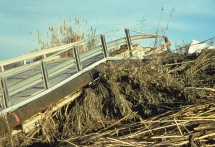Overview
Arundo (giant reed) is a perennial, clump-forming grass that has invaded riparian areas in Mediterranean-type, subtropical, and semi-arid climates worldwide. It is the largest of six species in the genus Arundo and is one of the tallest grasses in the world. Dispersal and reproduction occur primarily through transport of rhizome fragments that break off during seasonal flooding events and are carried to new sites where populations establish. Arundo has been observed flowering annually between August and October in desert populations, but in coastal habitats of California, flowering occurs irregularly among years and sites (A. Lambert, personal observations). Its flowers are perfect (Tucker 1990), but neither pollen nor seeds have been documented in North America (Johnson et al. 2006) and no seeds have been found in Europe (Lewandowski et al. 2003).
Origin
Arundo is considered native to eastern Asia (Polunin and Huxley 1987), but recent data on insect diversity and abundance (Dudley et al. 2008), as well as historical records (Bell 1997) suggest a Mediterranean origin.
Introduction
Arundo has been cultivated across Asia, southern Europe, North Africa, and the Middle East for thousands of years (Perdue 1958) and was first introduced to the New World in the early 1800s from the Mediterranean region (Bell 1997). It was extensively planted along ditches for erosion control and around other sites as a visual ‘screen'. Plants have been maintained in rural areas for fence material, roof thatching and construction of baskets and other artisanal products, and for food preparation (tamale wraps). The plant has been cultivated in plantations in California (now terminated), Argentina and France for production of reeds for musical instruments, and is also popularly used to construct informal flute-like instruments. Because of its rapid biomass production, A. donax is a proposed candidate for biofuel development in North America (Barney and DiTomaso 2008; Mack 2008) and other warm regions of the world (Seca et al. 2000). Despite the invasive nature of Arundo, the species continues to be sold horticulturally throughout the United States, including a ‘variegated’ form that is known to have escaped in some areas (T. Dudley, unpub. data).
Ecological Effects
Arundo invasion has many purported ecological and environmental impacts, (Bell 1997, Dudley 2000). It has been classified as a noxious weed by the state of California and the California Invasive Plant Council lists it among the top five invasive species degrading natural ecosystems in the State (Cal-IPC 2006). Invasion in riparian areas alters the native vegetative structure (Herrera and Dudley 2003), and rapid growth following floods or wildfire leads to competitive displacement of native riparian vegetation such as cottonwood/willow woodlands (Coffman et al. 2010). This dominance reduces arthropod diversity and abundance (Herrera and Dudley 2003) and also leads to decline in avian diversity and abundance (Kisner 2004).
Arundo is a notorious fire promoter and has transformed riparian areas into fire prone systems. Native riparian vegetation has high leaf water content, which reduces flammability and causes these systems to act as natural fire buffers, preventing the spread of wildfires across the landscape. However, the presence of Arundo often reduces the buffering capacity of riparian areas by generating large amounts of fine fuels that are easily ignitable (Coffman et al. 2010, Lambert et al. 2010). The presence of these fuels increases wildfire risk and can potentially alter fire regimes in riparian systems. Although fires adversely affect native riparian plants, Arundo recovers quickly through growth from rhizomes and roots, and can dominate a system after a few fire cycles.
Potential Control
Control measures against Arundo have been widely implemented in California, Texas, Nevada, and other states, including herbicidal control, cutting and removing biomass, and prescribed fire (Bell 1997). Herbicides, such as glyphosate and imazapyr, are commonly used as part of a control program, and proper timing and concentration of herbicide application have been shown to be critical factors in the success of programs. These measures often have short-term efficacy and can incur collateral damage on non-target species (Boose and Holt 1999).
Arundo was identified as a target for biological control in the late 1990’s (Tracy and Deloach 1998), and since then, two European insects have been introduced into Texas. A stem galling fly (Tetramesa romana) was released in southern Texas in 2010, but we found this insect was already present in California in 2007 (Dudley et al. 2008) with little impact on Arundo growth. A scale insect (Rhizaspidiotus donacis) that feeds at the base of stems and on rhizomes was released in southern Texas in 2011 (J. Goolsby, pers. comm.). The scale insect feeds at the base of arundo stems and on rhizomes near the soil surface. Current studies are evaluating the impact of scale feeding on aboveground and rhizome growth.





